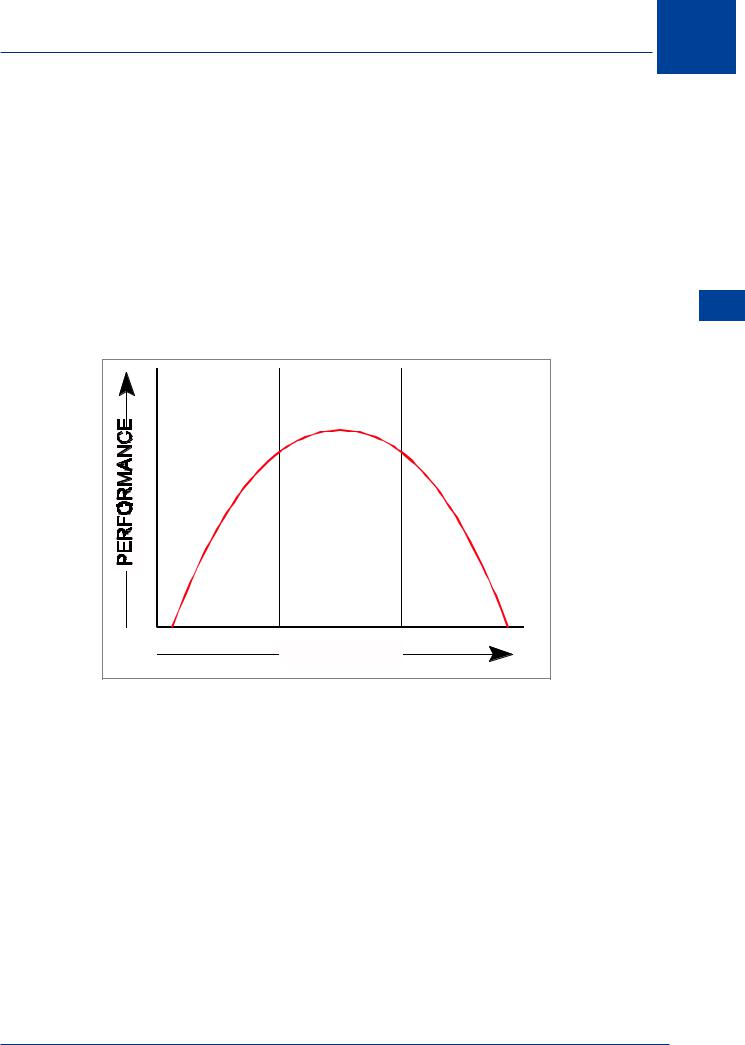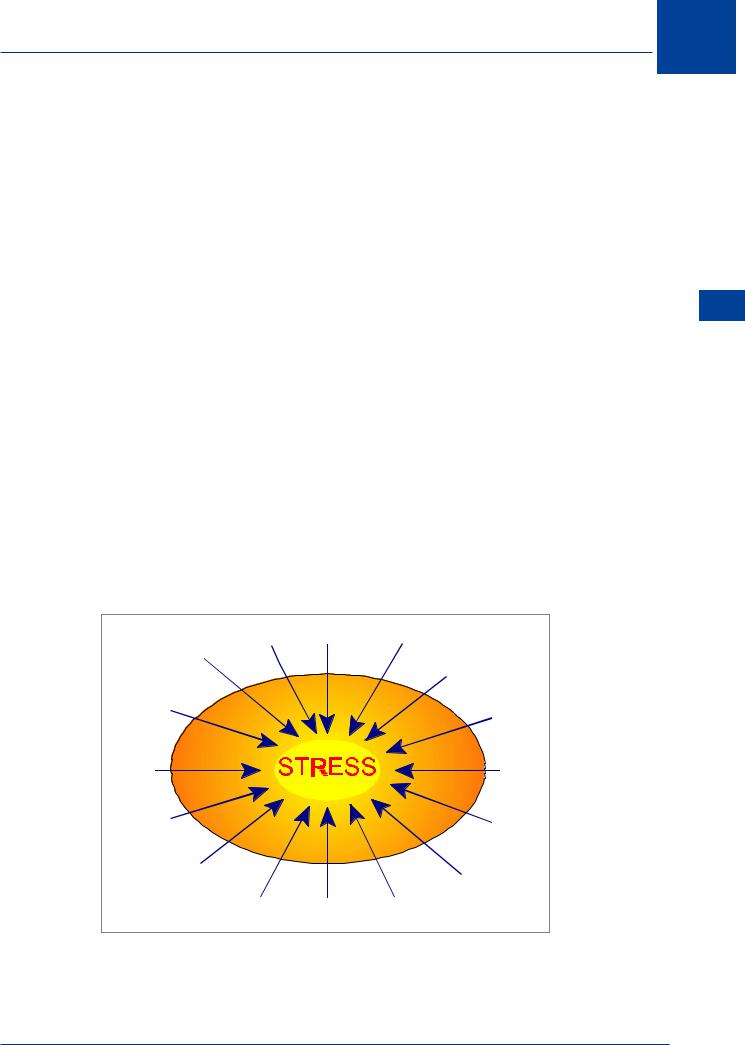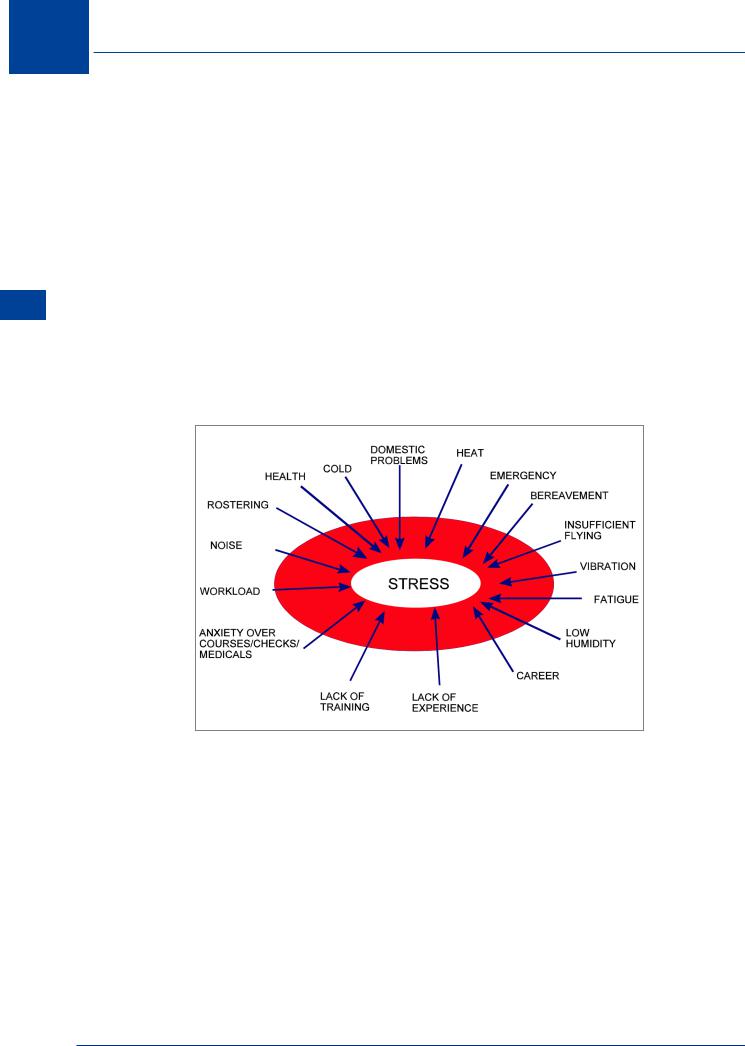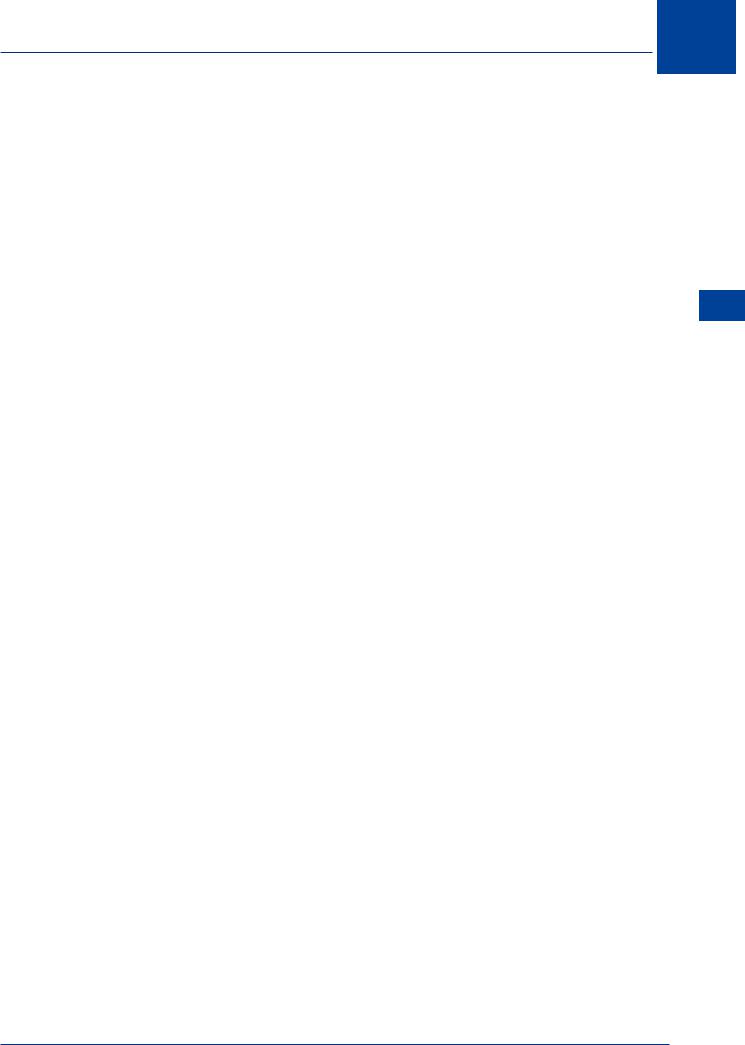
- •Textbook Series
- •Contents
- •1 Basic Concepts
- •The History of Human Performance
- •The Relevance of Human Performance in Aviation
- •ICAO Requirement for the Study of Human Factors
- •The Pilot and Pilot Training
- •Aircraft Accident Statistics
- •Flight Safety
- •The Most Significant Flight Safety Equipment
- •Safety Culture
- •Reason’s Swiss Cheese Model
- •The Five Elements of Safety Culture
- •Flight Safety/Threat and Error Management
- •Threats
- •Errors
- •Undesired Aircraft States
- •Duties of Flight Crew
- •2 The Circulation System
- •Blood Circulation
- •The Blood
- •Composition of the Blood
- •Carriage of Carbon Dioxide
- •The Circulation System
- •What Can Go Wrong
- •System Failures
- •Factors Predisposing to Heart Attack
- •Insufficient Oxygen Carried
- •Carbon Monoxide
- •Smoking
- •Blood Pressure
- •Pressoreceptors and their Function Maintaining Blood Pressure
- •Function
- •Donating Blood and Aircrew
- •Pulmonary Embolism
- •Questions
- •Answers
- •3 Oxygen and Respiration
- •Oxygen Intake
- •Thresholds of Oxygen Requirements Summary
- •Hypoxic Hypoxia
- •Hypoxic Hypoxia Symptoms
- •Stages/Zones of Hypoxia
- •Factors Determining the Severity of and the Susceptibility to Hypoxic Hypoxia
- •Anaemic Hypoxia
- •Time of Useful Consciousness (TUC)
- •Times of Useful Consciousness at Various Altitudes
- •Effective Performance Time (EPT)
- •Hyperventilation
- •Symptoms of Hyperventilation
- •Hypoxia or Hyperventilation?
- •Cabin Pressurization
- •Cabin Decompression
- •Decompression Sickness (DCS)
- •DCS in Flight and Treatment
- •Questions
- •Answers
- •4 The Nervous System, Ear, Hearing and Balance
- •Introduction
- •The Nervous System
- •The Sense Organs
- •Audible Range of the Human Ear and Measurement of Sound
- •Hearing Impairment
- •The Ear and Balance
- •Problems of Balance and Disorientation
- •Somatogyral and Somatogravic Illusions
- •Alcohol and Flying
- •Motion Sickness
- •Coping with Motion Sickness
- •Questions
- •Answers
- •5 The Eye and Vision
- •Function and Structure
- •The Cornea
- •The Iris and Pupil
- •The Lens
- •The Retina
- •The Fovea and Visual Acuity
- •Light and Dark Adaptation
- •Night Vision
- •The Blind Spot
- •Stereopsis (Stereoscopic Vision)
- •Empty Visual Field Myopia
- •High Light Levels
- •Sunglasses
- •Eye Movement
- •Visual Defects
- •Use of Contact Lenses
- •Colour Vision
- •Colour Blindness
- •Vision and Speed
- •Monocular and Binocular Vision
- •Questions
- •Answers
- •6 Flying and Health
- •Flying and Health
- •Acceleration
- •G-forces
- •Effects of Positive G-force on the Human Body
- •Long Duration Negative G
- •Short Duration G-forces
- •Susceptibility and Tolerance to G-forces
- •Summary of G Tolerances
- •Barotrauma
- •Toxic Hazards
- •Body Mass Index (BMI)
- •Obesity
- •Losing Weight
- •Exercise
- •Nutrition and Food Hygiene
- •Fits
- •Faints
- •Alcohol and Alcoholism
- •Alcohol and Flying
- •Drugs and Flying
- •Psychiatric Illnesses
- •Diseases Spread by Animals and Insects
- •Sexually Transmitted Diseases
- •Personal Hygiene
- •Stroboscopic Effect
- •Radiation
- •Common Ailments and Fitness to Fly
- •Drugs and Self-medication
- •Anaesthetics and Analgesics
- •Symptoms in the Air
- •Questions
- •Answers
- •7 Stress
- •An Introduction to Stress
- •The Stress Model
- •Arousal and Performance
- •Stress Reaction and the General Adaption Syndrome (GAS)
- •Stress Factors (Stressors)
- •Physiological Stress Factors
- •External Physiological Factors
- •Internal Physiological Factors
- •Cognitive Stress Factors/Stressors
- •Non-professional Personal Factors/Stressors
- •Stress Table
- •Imaginary Stress (Anxiety)
- •Organizational Stress
- •Stress Effects
- •Coping with Stress
- •Coping with Stress on the Flight Deck
- •Stress Management Away from the Flight Deck
- •Stress Summary
- •Questions
- •Answers
- •Introduction
- •Basic Information Processing
- •Stimuli
- •Receptors and Sensory Memories/Stores
- •Attention
- •Perception
- •Perceived Mental Models
- •Three Dimensional Models
- •Short-term Memory (Working Memory)
- •Long-term Memory
- •Central Decision Maker and Response Selection
- •Motor Programmes (Skills)
- •Human Reliability, Errors and Their Generation
- •The Learning Process
- •Mental Schema
- •Questions
- •Answers
- •9 Behaviour and Motivation
- •An Introduction to Behaviour
- •Categories of Behaviour
- •Evaluating Data
- •Situational Awareness
- •Motivation
- •Questions
- •Answers
- •10 Cognition in Aviation
- •Cognition in Aviation
- •Visual Illusions
- •An Illusion of Movement
- •Other Sources of Illusions
- •Illusions When Taxiing
- •Illusions on Take-off
- •Illusions in the Cruise
- •Approach and Landing
- •Initial Judgement of Appropriate Glideslope
- •Maintenance of the Glideslope
- •Ground Proximity Judgements
- •Protective Measures against Illusions
- •Collision and the Retinal Image
- •Human Performance Cognition in Aviation
- •Special Situations
- •Spatial Orientation in Flight and the “Seat-of-the-pants”
- •Oculogravic and Oculogyral Illusions
- •Questions
- •Answers
- •11 Sleep and Fatigue
- •General
- •Biological Rhythms and Clocks
- •Body Temperature
- •Time of Day and Performance
- •Credit/Debit Systems
- •Measurement and Phases of Sleep
- •Age and Sleep
- •Naps and Microsleeps
- •Shift Work
- •Time Zone Crossing
- •Sleep Planning
- •Sleep Hygiene
- •Sleep and Alcohol
- •Sleep Disorders
- •Drugs and Sleep Management
- •Fatigue
- •Vigilance and Hypovigilance
- •Questions
- •Answers
- •12 Individual Differences and Interpersonal Relationships
- •Introduction
- •Personality
- •Interactive Style
- •The Individual’s Contribution within a Group
- •Cohesion
- •Group Decision Making
- •Improving Group Decision Making
- •Leadership
- •The Authority Gradient and Leadership Styles
- •Interacting with Other Agencies
- •Questions
- •Answers
- •13 Communication and Cooperation
- •Introduction
- •A Simple Communications Model
- •Types of Questions
- •Communications Concepts
- •Good Communications
- •Personal Communications
- •Cockpit Communications
- •Professional Languages
- •Metacommunications
- •Briefings
- •Communications to Achieve Coordination
- •Synchronization
- •Synergy in Joint Actions
- •Barriers to Crew Cooperation and Teamwork
- •Good Team Work
- •Summary
- •Miscommunication
- •Questions
- •Answers
- •14 Man and Machine
- •Introduction
- •The Conceptual Model
- •Software
- •Hardware and Automation
- •Intelligent Flight Decks
- •Colour Displays
- •System Active and Latent Failures/Errors
- •System Tolerance
- •Design-induced Errors
- •Questions
- •Answers
- •15 Decision Making and Risk
- •Introduction
- •The Mechanics of Decision Making
- •Standard Operating Procedures
- •Errors, Sources and Limits in the Decision-making Process
- •Personality Traits and Effective Crew Decision Making
- •Judgement Concept
- •Commitment
- •Questions
- •Answers
- •16 Human Factors Incident Reporting
- •Incident Reporting
- •Aeronautical Information Circulars
- •Staines Trident Accident 1972
- •17 Introduction to Crew Resource Management
- •Introduction
- •Communication
- •Hearing Versus Listening
- •Question Types
- •Methods of Communication
- •Communication Styles
- •Overload
- •Situational Awareness and Mental Models
- •Decision Making
- •Personality
- •Where We Focus Our Attention
- •How We Acquire Information
- •How We Make Decisions
- •How People Live
- •Behaviour
- •Modes of Behaviour
- •Team Skill
- •18 Specimen Questions
- •Answers to Specimen Papers
- •Revision Questions
- •Answers to Revision Questions
- •Specimen Examination Paper
- •Answers to Specimen Examination Paper
- •Explanations to Specimen Examination Paper
- •19 Glossary
- •Glossary of Terms
- •20 Index

Stress 7
is not fully functioning. The individual will have a slow environmental scan and may miss information. Thus performance is low.
At the optimal arousal level we are at our most efficient - we have enough demands to keep our attention and the capability to deal with complex tasks.
At high arousal levels our performance starts to deteriorate, errors are made and information may be missed. We will suffer from a narrowing of attention as we tend to focus on a limited source of data. At very high arousal levels we experience overload as we reach a limit of processing capacity and/or our ability to complete all the tasks. This funnels our attention to events which we perceive as being relevant to the perceived primary task. Thus information may be missed from important, but more peripheral and non-attended sources.
At these high levels the attention mechanism can reject vital information solely due to overload.
|
OPTIMAL |
|
LOW |
AROUSAL |
HIGH |
AROUSAL |
|
AROUSAL |
|
AROUSAL |
|
|
(STRESS) |
|
Figure 7.2 The relationship between arousal and performance (Yerkes Dodson)
Stress Reaction and the General Adaption Syndrome (GAS)
The General Adaptation Syndrome (GAS) is the term used to describe the mechanism by which the individual reacts to an outside real, perceived or anticipated threat.
The ANS and the GASTrigger
The syndrome is triggered by the arousal mechanism which operates through the Autonomic Nervous System (ANS). As has been discussed, this controls many of the body’s essential functions: respiration, circulation, digestion, etc. over which we have normally no conscious control. The state of homeostasis is maintained by this system. The ANS is divided into two branches:
•The Sympathetic branch.
•The Parasympathetic branch.
These control systems are neurohormonal in their makeup and are highly self-regulated under normal circumstances.
Stress 7
125

7 Stress
Stress 7
Sympathetic Branch
This provides the body with the resources to cope with a new and sudden source of stress, known as the FIGHT OR FLIGHT RESPONSE and its purpose is to prepare the body and mind for immediate physical activity.
Parasympathetic Branch
This prolongs the body’s mobilisation, to give it time to find a solution to the stressful situation, and restores the body to normal functioning when the perceived danger has passed.
TheThree Phases of the General Adaption Syndrome
•Alarm reaction.
•Resistance.
•Exhaustion.
Phase 1 - Alarm Reaction
In this, the alarm phase, the brain will start a reaction - depending on past experience - to the stimulus. The brain will adapt and colour (pleasure or displeasure) the perceived event. The sympathetic branch is triggered to mobilise the body and allow it to react. The suprarenal (adrenal) glands play an important part in the process as they secrete the stress hormone - adrenaline.
This causes a massive release of sugar reserves from the liver and also brings about the following bodily reactions:
•The pupils of the eye dilate.
•The flow of saliva is inhibited.
•The heart rate increases.
•The rate and depth of breathing increases.
•The bronchi dilate to allow a greater volume of air (oxygen) to the alveoli.
•Peristalsis (the movement of food along the digestive system) is inhibited.
•Bladder contraction is inhibited.
•Blood pressure increases.
•Blood flow to the muscles increases.
•Muscles are tensed.
•The senses are sharpened.
Adrenaline causes all of the above to increase the body’s resources by increasing the energy available. This initial defence mechanism, common to all animals, is relatively primitive - it allows one to react physically and has only indirect effects on the brain. These are:
•Acceleration of the activities of the brain.
•Improved quality of immediate decisions.
•A speeding up of the decision-making process.
•Memory improvement.
•Improved alertness.
Phase 2 - Resistance
This is when the parasympathetic system takes over and attempts to prolong the mobilization of the body’s resources to give time to find a solution. A different stress hormone cortisol (cortisone) is released which assists the body to quickly convert fats to sugar to maintain the supply of energy to the muscles.
126

Stress 7
This hormone also acts on the brain to improve the memory of stress situations, which is why we remember these events particularly intensely. If, however, an individual is exposed to stress for too long, his/her energy resources become depleted.
Phase 3 - Exhaustion
Occurs over a variable period and will normally affect only specific parts of the body. With rest, this exhaustion stage is temporary but, if allowed to continue without respite, it can result in death as the defence mechanism completely shuts down.
The stress hormones, adrenaline and cortisol generate waste matter which must be eliminated. This is not an easy process and some secondary effects may occur. If the stress situation is coped with successfully or the stressors are removed, the body will gradually return to its normal (homeostatic) state.
It is of note that stress may be “good” or “bad” and that most stressors increase the arousal level.
TheThree Reactions of the General Adaption Syndrome
•Psychological Reaction: where the brain registers fear, alarm or crisis.
•Psychosomatic Reaction: during which the brain triggers the release of hormones, adrenaline and sugars into the blood.
•Somatic Reaction: the responses of the various organs of the body to the hormonal and chemical releases.
Stress Factors (Stressors)
The figure below illustrates, in general terms, some of the possible stress factors (stressors) to which we may be exposed.
COLD |
DOMESTIC |
EMERGENCY |
PROBLEMS |
||
WORKLOAD |
|
SEXUAL |
|
|
|
|
|
PROBLEMS |
LACK OF |
|
|
TRAINING |
|
HEALTH |
NOISE |
|
HEAT |
MOVING |
|
|
HOUSE |
|
VIBRATION |
BEREAVEMENT |
|
LOW HUMIDITY |
|
|
|
PROMOTION |
MONEY |
LACK OF |
|
WORRIES |
EXPERIENCE |
Figure 7.3 Possible stressors
Stress 7
127

7 Stress
Stress 7
Categories of Stress Factors
The stressors above can be broadly subdivided into:
•Physiological.
•Cognitive.
•Non-professional.
•Imaginary.
•Organizational.
Physiological Stress Factors
This category can be broken down into two parts:
•External physiological factors (noise, temperature, vibrations etc.), sometimes known as environmental stress.
•Internal physiological factors (hunger, fatigue, lack of sleep etc.).
Figure 7.4 Some flight deck stress factors
External Physiological Factors
Discussion will be limited to those stressors associated with aviation.
Flight Deck External Physiological Factors
There are a number of possible physical sources of stress; heat, vibration, noise etc. As we have seen, the effects of stress are cumulative and the negative consequences of one source are likely to lower an individual’s resistance to other forms of stress.
Heat and Cold
A comfortable temperature for most people in normal clothing is around 20°C.
Above 30°C, heart rate, blood pressure and sweating increase.
128

Stress 7
Below 15°C the individual becomes uncomfortable and may lose feeling and some control in the hands, especially for fine muscle movement.
The body’s reaction to extreme heat is discussed later in this chapter.
Noise
When bored or fatigued, some noise can raise arousal levels and increase performance. Excessive noise (above about 90 dB) will disrupt performance and cause:
• |
Disrupted concentration. |
|
|
• |
Degradation of information being received in the working memory, leading to an increase |
7 |
|
|
in workload. |
Stress |
|
• An increased number of crew errors. |
|||
|
|||
In designing aircraft warnings for system failures, care must be taken to ensure that the aural warnings should attract attention but not startle the crew.
Vibration
Vibration may affect the whole body, or specific parts thereof. Any vibration will cause fatigue and can affect both visual and motor performance, leading to uncomfortable symptoms.
The frequency of the vibration will determine which parts are affected and the magnitude of the vibration will determine the severity of the symptoms.
Frequency |
Effects/Symptoms |
|
|
|
|
1 to 4 Hz |
Interferes with breathing. |
|
|
|
|
4 to 10 Hz |
Chest and abdominal pains. |
|
|
|
|
8 to 12 Hz |
Backache. |
|
|
|
|
10 to 20 Hz |
Headache, eyestrain, pains in the throat, speech difficulties and |
|
muscular tension plus degradation of visual acuity. |
||
|
||
|
|
Resonances of 30 - 40 Hz applied to the whole body will interfere with the human responses. If applied to the head, although no physical damage is done to the eye, there is a possibility that visual acuity may be degraded.
Resonance of the skull itself occurs at a frequency of approximately 1 - 4 Hz. This may also affect vision.
Crew seats with anti-vibration mountings help to reduce the levels.
Helicopters can vibrate in all three axes at frequencies related mainly to rotor, gearbox and engine speeds. Helicopter pilots will, therefore, be particularly susceptible to this stress factor.
129

7 Stress
Stress 7
Low Humidity
The air conditioning system of a modern aircraft draws air from outside the aircraft via the engine’s compressor. At airline operating altitudes the temperature may be as low as -30°C to -55°C. At these temperatures the air is very dry, with a relative humidity as low as 5%. For comfort man requires a relative humidity of 40% to 60%. At low humidity the individual becomes uncomfortable due to drying out of the mucous membranes of the nose and throat. Eyes become sore as the tears evaporate rapidly and the tear ducts dry. Water vapour is added to the cabin environment during respiration, but as the air is continually replaced this will have a limited effect in increasing the cabin humidity. It would be possible to add water to the cabin air but the weight penalty of extra water to be carried is not considered commercially viable. It is not advisable to take on a lot of extra fluids in these circumstances but drink only enough to maintain comfort.
Note: Humidity in the cockpit typically varies between 5% and 15%. Thus flight crew should drink sufficient fluids in flight to avoid dehydration. During flight, the relative humidity in the cabin is similar to a dry summer climate or to being indoors in the wintertime.
Caffeine and alcoholic beverages actually contribute to dehydration.
Dry air may cause irritation of the eyes especially if contact lenses are worn and these may have to be removed.
Dry air can also aggravate allergies or asthma.
The humidity control system within some aircraft may alleviate this problem.
In general, human performance is poor in an environment which is humid, regardless of the ambient temperature. Surroundings which are both dry and warm are most conducive to high performance.
ExtremeTemperature Stress Factors
The human body is extremely sensitive to heat and cold and functions efficiently only over a remarkably small temperature range. The normal oral temperature is considered to be between 36.1°C (97°F) and 37.2° (99°F). Physical and mental performance starts to become significantly impaired at an internal body temperature of about 38°C. Apart from the skin and fat, which both act as insulators, the body has mechanisms, controlled by the ANS, which endeavour to cope with the change of body temperature and maintain equilibrium (sweating and shivering for example). When the body, however, is exposed to extreme temperatures with which these internal homeostatic mechanisms cannot cope, it reacts violently.
Extreme Heat Stress
Once the blood temperature rises to approximately 41°C (106°F), the self-regulatory systems of the body can no longer cope and the effects of extreme heat are:
•Excessive sweating leading to fast depletion of body fluids and electrolytes.
•This dehydration leads to a further rise in body temperature, thus exacerbating the situation. Typical symptoms are: muscle cramps, giddiness, and fatigue.
•Rapid increase of the heart rate and an associated need for more oxygen.
•Thirst.
130
